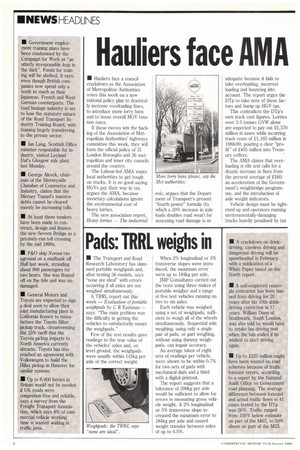Pads: TRRL weighs in
Page 6

If you've noticed an error in this article please click here to report it so we can fix it.
• The Transport and Road Research Laboratory has slammed portable weighpads and, after testing 36 models, says "none are ideal" with errors occurring if all axles are not weighed simultaneously.
A TRRL report out this week — Evaluation of portable weighpads by C R Eastman — says: The main problem was the difficulty in getting the vehicles to satisfactorily mount the weighpads."
Few of the test results gave readings to the true value of the vehicles' axles and, on level ground, the weighpads were usually within 145kg per axle of the correct weight. When 2% longitudinal or 5% transverse slopes were introduced, the maximum error went up to 184kg per axle.
,IMP Consultants carried out the tests using three makes of portable weigher and a range of five test vehicles running on two to six axles.
Each vehicle was weighed using a set of weighpads, sufficient to weigh all of the wheels simultaneously. Sequential axle weighing, using only a single pair of pads, or part weighing, without using dummy weighpads, can impair accuracy.
An average taken of eight sets of readings per vehicle, were shown to be within 0.7% for two sets of pads with mechanical dials and a third with a digital printout.
The report suggests that a tolerance of 200kg per axle would be sufficient to allow for errors in measuring gross vehicle weight. A 2% longitudinal or 5% transverse slope increased the maximum error to 184kg per axle and caused weight transfer between axles of up to 4.5%.
































































































